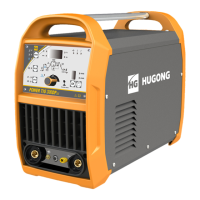What to do if protection indicator lights up on my HUGONG POWERTIG 300DPIII?
- DDavid NicholsAug 15, 2025
If the protection indicator light is on, it could be due to inner overheating. In this case, wait for the inner temperature to decrease for the machine to recover to normal. Alternatively, it might be due to a power supply issue with over or lack of pressure exceeding 15%. The machine should recover when the voltage returns to normal.


